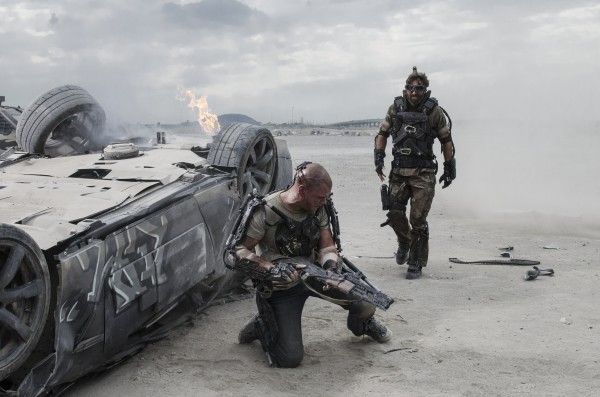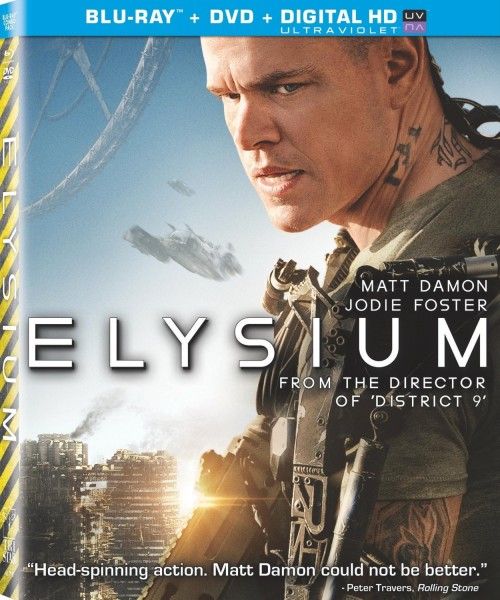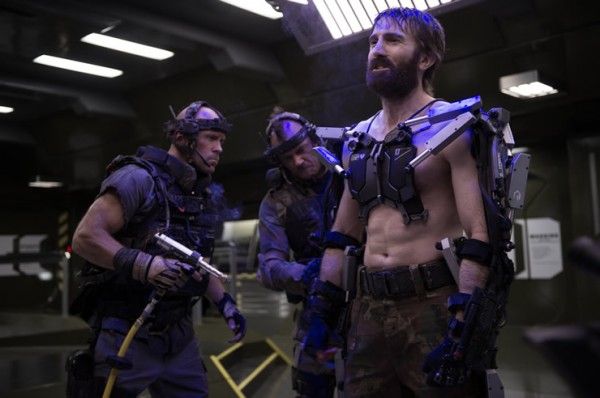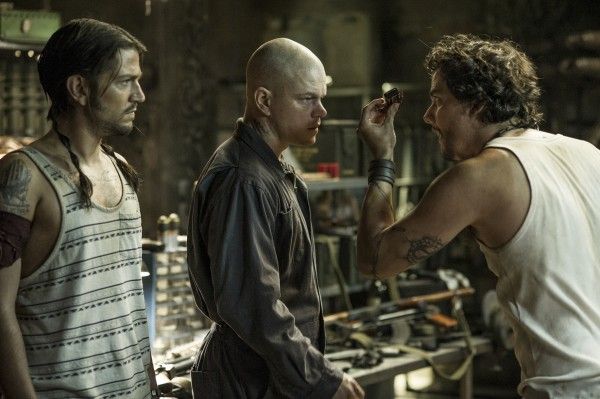Out on Blu-ray December 17th is Elysium, Neill Blomkamp’s sophomore film about class disparity in a bleak futuristic vision of Earth. While the film boasts an impressive cast including Matt Damon, Jodie Foster, Diego Luna, William Fitchner and Alice Braga it’s the tremendous special effects that ended up stealing the show. Elysium was recently named by The Motion Picture Academy of Arts & Sciences alongside films like Pacific Rim and Gravity as one of the ten pictures set to vie for the Best Visual Effects Oscar.
At the recent Autodesk CAVE conference in Las Vegas I had the opportunity to attend a class about Elysium’s impressive effects work and interview the film’s Overall Effects Supervisor Peter Muyzers. As someone who’s always been impressed and intrigued by effects artists it was an exciting opportunity to get an inside look at the intricate process of their work. During the interview he talked about what made Elysium significantly more challenging than District 9, collaborating with Blomkamp, his favorite shot of the film, creating convincing effects on a budget, Blomkamp’s next picture Chappie, and more. Check out what he had to say after the jump.
Question: You said in your presentation that Image Engine was established in 1995, were you there at the beginning? What point did you come in?
PETER MUYZERS: No, I joined the company in 2006 when I was brought on board to help build the feature film division. At that point the company was primarily working on television series like Stargate and so on. They had the desire to break into film, but they didn’t know exactly how to do that. My career before was at the moving picture company in the UK, in London, so when I came to Canada I helped kind of build it up.
Is that how you met Neill Blomkamp?
MUYZERS: Yes, shortly after we built this division for feature films we had this idea that we wanted to work on some great films, but we didn’t know what films they were going to be. I was kind of like “build it and they will come” kind of idea where we going to build the studio, we had no clients at the time, and we were hoping that when we could show to potential clients what we were capable of that they would say, “Oh yeah, this is a great studio. Let’s do the work with you guys.” So it was just fortunate that Neill contacted us and said, “Hey I’ve got this project that has multiple shots with Aliens in them and mother ships, is that something you guys can do?” And we’re like “Yeah! We’re ready for that!” So that was like we built it and Neill came. It was perfect timing how he came to image Engine. So we completed that show and were talking already about Elysium.
Can you talk a little bit about working with Neill and what his style is like as a director? What’s he like to collaborate with?
MUYZERS: Neill is a visionary. He really knows what he wants. He knows how to communicate it to everyone on the team; the visual effects, the costume designers, the art department people, the special effects people. He savors that relationship that you create with all these people and then he really wants to stick with that crew all the way through the show and on his next film. he would like to work with the same people on the next project. Maybe some of the people he doesn’t like to work with, they don’t get to work with him again, but for the most part he somehow managed to get this great group of people together from all over the world and trying to recreate that is often very challenging. Because everyone has other projects they’re working on and so on, but Neill is very much the kind of director that says, “I worked with you before, I loved working with you, and I want to work with you again.” Because what happens is you develop that short hand. You can just nod, or gesture or do something and then I can just read him from that and say, “oh, he’s frustrated about something. What’s going on here?” That shorthand is very important. A lot of that just depends on just developing a good relationship with the director. For some reason he seems to get along with myself and the entire team at Image Engine.
You said that Elysium was in many ways a bigger challenge than District 9. Talk a little bit about why that is and what some of those challenges were.
MUYZERS: Yeah, so even though we’re talking about this idea that he had, this film called Elysium, during production of District 9 it became clear to me right away that this was going to be very different. It wasn’t just going to be like, “Oh this is the same style.” It was going to be a very different style. It was going to be bigger, grander, more epic, different camera choices, different shooting style and so on. And he didn’t have a lot more money either so it wasn’t like it was suddenly going to be a big blockbuster production. So that was quite an interesting challenge. How do you do more variations, more complicated work, more detailed work, more volume of visual effects shots when you don’t necessarily have that much more money to spend? And that really relates to how efficient we were during District 9 and the pipeline that we built at the company to handle the kind of work that we’re doing. Having worked with Neill before we were able to prepare well in advance for Elysium and really get things into place. So the real challenges on that film were just the variety of character work, the complexity of the asset build for the ring, to design that. There were about three times as many shots in Elysium as there were in District 9 from a visual effects point of view. So I think that was the combination of challenges that we had to overcome.
You pinpointed his favorite shot of the ship taking off, what was one of your favorite shots or something that you’re most proud of?
MUYZERS: It’s easy for me to say the same one, but that’s not necessarily true. There’s a couple of shots in the film that I really like. One of them is actually an establishing shot of we see Earth, there’s the sun in the shot, the sun is glancing off the ocean. It’s taken as if we’re in the ISS space station, and it was inspired by a photograph that an astronaut took. In the photograph we see a moon in the distance rising up from behind earth, so in our version we put Elysium as a space station rising behind earth. You can see it through the atmosphere getting distorted. It’s a very non-attention shot, but just the beauty of it, the sun sparkling on the water. It’s actually one of my favorite shots in the entire film.
I think one of the flashiest shots is that exploding droid. Certainly when I watched it I was like, “Wow!”
MUYZERS: [Laughs] Yeah, that was quite spectacular. I would say that shot comes a very close second to being one of my favorite shots. That was one of those one-off shots, one-off ideas that he had. It was a key moment in how ultimately this character Max would overcome these very strong droids that were about to kill him and his friends. Neill really wanted to slow that time down so you could savor the destruction of that droid, because everyone is like, “Yeah, finally!”
You said that you worked with a number of other companies, I think eight in total including your company, and your job was the overall effects supervisor. Can you talk a bit about what that title means and what you do in that capacity?
MUYZERS: Yeah the real challenge of being the overall effects supervisor is not just having to focus on when you execute the work at any particular visual effects company, but you also have to work with the editorial department, and Neill as the director to help him figure out a variety of problems or differences or changes he wants to make to the movie. So it’s really a role that takes me away from the day to day activities at the studio. I need to be within the editorial offices at Neill’s creative space. I can help him and he can help me figure out how we execute the work. So my time is really split between being at the production office and being at the studio. Every studio, including Image Engine, has their own supervisor that focuses on the day to day at the studio and doesn’t concern themselves with anything else, but because I was splitting up the work I obviously had to go to reviews with these other studios. I would have to go to Moving Picture Company, I would have to go to Method Studios, Embassy VFX and give those artists their feedback based on Neill. We would have calls with ILM and time to time fly down and meet with ILM to give them feedback.
In the behind the scenes featurette on the Blu-ray it shows how you guys used human stand-ins for the droids and used real helicopters for the Raven scenes. Is that something that’s kind of standard practice or was that a unique tactic used for this film?
MUYZERS: I believe every film should adopt that practice. It’s a work flow that’s just basic, simple and cost-effective, but highly effective as an end result. And you don’t need a lot of technology to do that. It’s a suit you can put on. You may have to convince your actors to put that on [laughs] and not feel embarrassed wearing a grey leotard. Ultimately it’s just the simplicity of some of those things that you can achieve high-quality results on a compromised budget. Unfortunately we did not have the budget of other high-end films like Avatar or Lord of the Rings. They would perhaps adopt a technological way of capturing the movements of some of these creatures and then translate those movements into the computer and have a digital character that way. The way we did it was simply manually, frame by frame, copying the movement of the actors. So it was a process. It takes time, but still it’s much more cost-effective than millions of dollars spent on technology that sometimes may work, sometimes it could break down. We’ve seen it in other films before we did District 9, so it’s not like we came up with this. ILM has been using this approach for many years on Pirates of the Caribbean and so on, and there have been a few other films that have used that approach. It’s a work flow, it’s not necessarily technology.
I’m curious, does that makes things more challenging or easier on your end as opposed to the more technological approach?
MUYZERS: Well you’ll always have an issue with technology of whether or not it works on set and time on set costs money. So if you can show up with technology that is going to work, guaranteed, the camera’s going to go, the lights are going to go, you can call action and everything’s working, I think people get familiar with that. They get used to that and can appreciate that. But more than often there’s always something going on, there’s a glitch, it just doesn’t work…then what do you do? Do you fall back to a manual approach? Do you have a plan b? We said, “Look we’re not going to have time on set. Neill had a very short shooting schedule. And he simply said, “Look I don’t want to screw around with all these crazy technology ideas.” Even though he likes the thought of them. They take up too much time to set up on set and he just didn’t want to be affected by delays in shooting. So we removed all of those things on set that would burden him. He wants to have that creativity to walk around and choose the location and he didn’t want me as the effects supervisor saying, “Wait a minute. We have to rig this up and get more cable. We have to do this.” It’s like, how long is that going to take? That would not be good on a Neill film. He’s too impatient for those things.
You talked about how Neill wanted as much real life influence as possible in the designs and execution, but at a certain point like with the aerodynamics of the Raven, he would be okay with diverging realism. How did you guys toe the line between a true-to-life influence and the fact that this is a science fiction landscape?
MUYZERS: It was very hard for us to initially go down the route of realism, because you’re working on a science fiction film, working with these crazy designs of droids and space ships and so on. Your brain is calibrates because we think “This doesn’t exist; therefore I can make it up.” But Neill was just hammering down always that thought of – refer to the real world. Yes, the shape may not work in the real world, but it’s based on VTOL technology. For instance, the Raven is based on VTOL technology that exists in today’s world. It’s based on the Harrier jet or the F35 fighter jet that the US Air force uses. So you have real world references of aircraft being able to take off vertically, just like the Raven would take off vertically. It would be a little bit unstable, a little bit imperfect as it takes off and moves away. But then he would be creative in a way that he said, “Well they don’t have a cockpit window.” There’s no pilot seeing out. They’re using computer screens to fly this things and it’s all digitally controlled. So at some point you have to embrace the creative freedom of filmmaking and the liberties you can take with that. But for him, everything had to be rooted in some form of reality, in some form of things that you can grasp and understand. Because otherwise he felt that audiences wouldn’t believe it. If it was too far in the sci-fi world people would just be like, “Yeah, okay, that’s just made up stuff. I’m not buying it.” It’s always just about what can you do to suspend disbelief? And for him it was about all of those details; the fact that there was a handrail that was the same handrail inside of a tank, or this particular rivet or shape. We had to show that this came from this aircraft, this came from this tank, this came from this object and that’s how we got that inspiration and applied it to these fairly sci-fi looking space vehicles.
You guys are working on Chappie now; can you talk at all about what kind of effects you’re working on for that?
MUYZERS: No I can’t talk about that [laughs], I have to be very wishy washy. It’s another Neill Blomkamp film so I would expect that it’s going to be along the same lines of District 9 or Elysium. This one is about a robot that is going to be adopted by this crazy criminal family. So I cannot imagine how that is going to play out. They’re shooting it right now in South Africa. We’re working on the visual effects for that. I have one of my colleagues down there in South Africa this time so I’ve been able to wash my hands of the gritty world of Johannesburg. I’m looking forward to seeing what it looks like. I haven’t seen anything of what he’s doing in terms of the look. But I heard it’s somewhat comedy style, so it’s going to be crazy. It’s the same actor, Sharlto Copely, who was in both his previous films that is playing in this film and I can only imagine how crazy it’s going to be.




